Google Calendar is a core part of the Android productivity package — but if all you’re using is what you see on the app’s surface, you’re missing out on some pretty powerful possibilities.
Yes, oh yes: Just like so many of our modern digital tools, there’s more to Google Calendar than meets the eye. And while the majority of the service’s advanced options revolve around the Calendar website, the Calendar Android app has its share of handy out-of-sight options that are specific to the mobile experience. From time-saving shortcuts to efficiency-boosting options, they’re all things that have the potential to make your life easier in small but significant ways.
Find time in your agenda to check out these 12 hidden Google Calendar features on Android. Trust me: You’ll be glad you did.
1. The event creation quick-peek
Tell me if you can relate to this: You head into the Calendar app on your phone to create a new event. You open the screen to add the event in — then you suddenly find yourself facing a foggy mental blank.
What else did you have going on that day? Did you need to schedule the event for 2:00 p.m., or would 3:00 be better? When was that podiatrist appointment, again?
I’ve certainly been there (well, not to the podiatrist, specifically, but in the general event brain fog situation). And the Android Calendar app doesn’t do much to help offer any broader calendar context while you’re in the midst of adding in a new event.
Or so it’d seem. After years of using Google Calendar on Android, I just noticed a curiously camouflaged option that’ll change the way you create events on your phone.
See that barely noticeable light-gray line at the top of the Calendar app’s event creation screen? The one that looks vaguely like an arrow pointing downward?
 JR
JR Yup, that’s the one. The next time you’re adding a new event on your phone and you find yourself wondering what else is on your agenda around that same time, tap the line — or, alternatively, swipe downward anywhere within the main event creation area of the screen.
And…
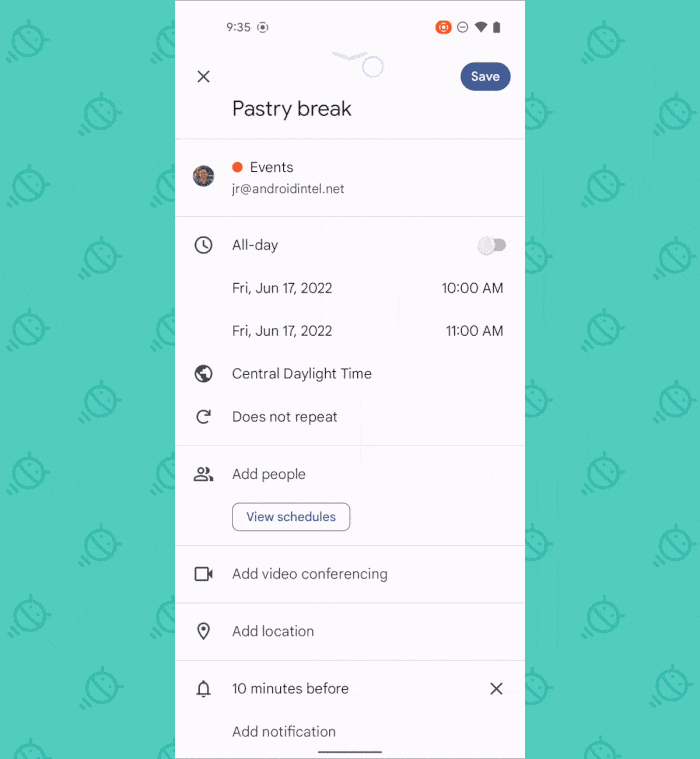 JR
JR Wouldya look at that?! You can actually minimize that event creation interface down and browse around on your calendar behind it.
And that’s not all…
2. Simple event sliding
After you’ve entered that concealed quick-peek view, remember this: If you decide you need to shift your new event around to another time, you can simply touch and hold the outline on your screen and slide your finger up and down to move it.
Nifty, no? And there’s one more piece to this puzzle yet…
3. An event adjusting gesture
In addition to sliding an event around to move it in the Calendar Android app’s event creation quick-peek interface, you can touch your finger to the dots on the top or bottom of your event’s outline and then slide up or down from there to make the event longer or shorter.
 JR
JR Now if only our actual meetings could be condensed down so easily!
4. Quick monthly calendar view
When you need to glance at a full-month view whilst thumbing through your events, take note of the following invisible Calendar shortcut: You can tap or swipe downward on the app’s top bar — where it says the current month’s name — to bring a monthly view into focus. Tap on the bar a second time (or swipe back up, with your finger starting just beneath that area) to hide it when you’re done.
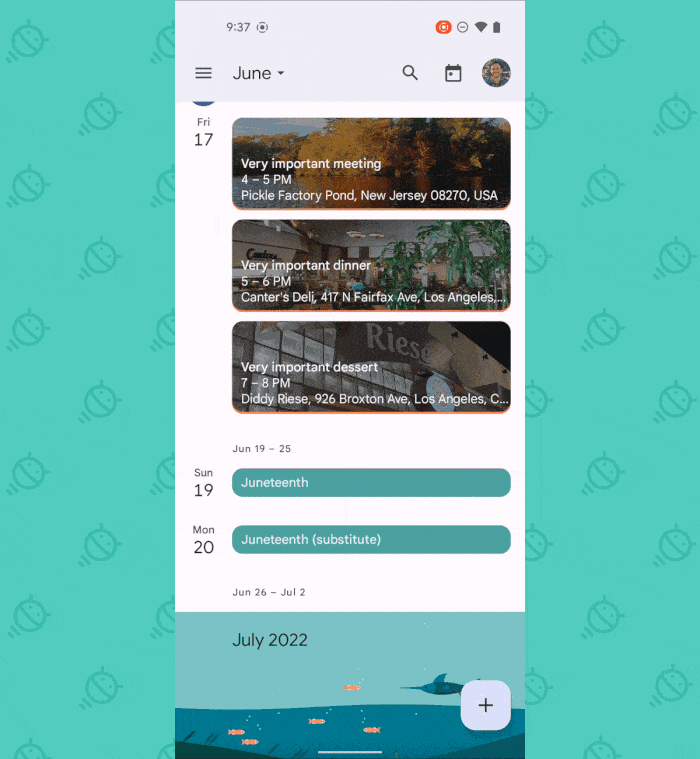 JR
JR Who knew?! And speaking of shadowy shortcuts…
5. A handy way to snap to today
Anytime you’re scrolling through your agenda view in the Calendar app and want to jump back to the current day, tap the small calendar icon (the box with a dot it in, directly to the left of your profile picture in the upper-right corner of the screen).
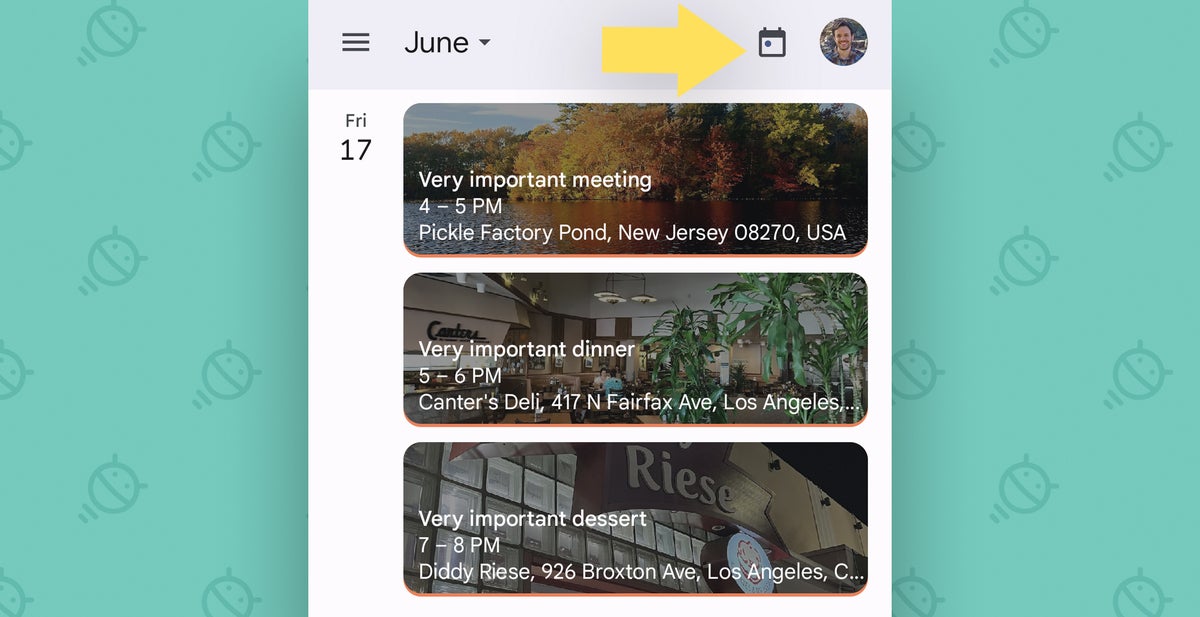 JR
JR That’ll zip you back to today, no matter how far into the future you’ve traveled.
6. Speedy deleting of events
Here’s an easily overlooked and incredibly handy gesture in the Calendar Android app: From the agenda view, you can swipe any event or reminder toward the right to delete it in a single, swift action.
 JR
JR So long, responsibilities!
7. The Meet omission
Have you ever noticed how Calendar developed an irksome habit of automatically adding Google Meet links into every forkin’ event you create?
That’s fine and dandy if your event actually includes a Meet-based video meeting, but it’s pretty annoying — and potentially confusing — when your event is something that’s in person. Worse yet is when your event is virtual but in a different video meeting service, like Zoom, and then everyone you invite ends up getting both the correct link and a meaningless Meet link for the same event.
Here’s a little secret: You can put a stop to this madness. And all it takes is a handful of quick taps in your Android Calendar app.
Open up Calendar on your phone, tap the three-line menu icon in its upper-left corner, and scroll down to the bottom to select “Settings.”
Tap “General,” then tap “Add video conferencing” and turn the toggles into the off position for every account you’ve got connected.
Now, if you ever want to add a Meet link to an event, you can do so manually whilst creating said event. But by default, those blasted links won’t get auto-added onto every single event for you.
8. Event-sensitive silencing of your phone
This one is technically an Android feature, but it works hand in hand with Calendar and is one of the most practical options out there: the ability for your phone to automatically silence itself anytime an event from your Google Calendar is underway.
All you’ve gotta do is enable it: Head into your phone’s settings and find the Do Not Disturb section (by either looking in the Sound section or simply searching for “Do Not Disturb” in the box at the top of the screen). Tap “Schedules,” bring your pretty little fingie to the line labeled “Event,” and either tap the line itself (not the toggle next to it) or the gear icon alongside it, if you see one.
That’ll pull up a screen that looks something like this:
 JR
JR The first option on the screen, “During events for,” lets you select which of the calendars associated with your device will trigger the phone-silencing behavior. You can leave it set to the default setting of “Any calendar” to have any event on any calendar cause your phone to be silenced, or you can narrow it down to one specific calendar — like your work calendar — and leave the others out.
The second line lets you specify what types of events will cause your phone to be silenced. You can tell the system to silence your phone only if you’ve replied “Yes” to an event, if you’ve replied “Yes” or “Maybe,” or if you’ve replied “Yes” or “Maybe” or haven’t replied at all. (Those choices are for events that other people created and invited you to attend, by the by; any event you create on your own will always count as an automatic “Yes.”)
And finally, the third line lets you decide whether your phone should use its default Do Not Disturb behavior or if you’d rather create your own custom settings for how the phone should behave in this specific circumstance. The custom settings option gives you tons of flexibility for how exactly your phone should act while a Calendar event is underway: You can opt to allow calls or texts from starred contacts to come through, for example, or to let events and reminders alert you even if no other sounds are permitted. You can even customize how different types of notifications appear visually during an appointment.
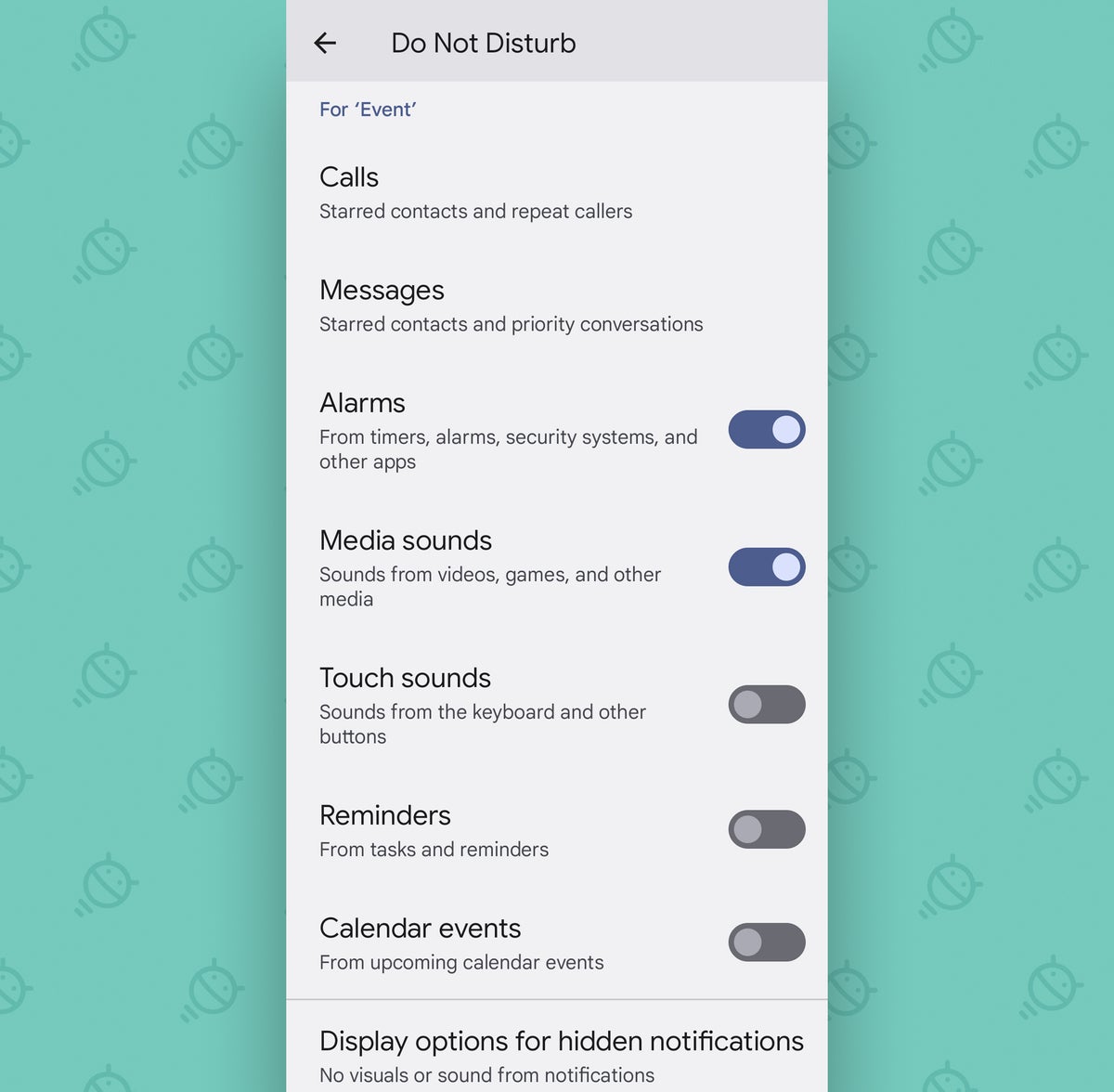 JR
JR Not seeing any of this on your device? If you’re using a phone with an older version of Android or one whose manufacturer has fudged around with this part of the operating system, you can set up your own simplified version of the same feature by embracing this IFTTT applet.
9. Quick responses for group events
Just like Android allows you to send a prewritten quick response when you’re rejecting a call, Google Calendar can let you send a speedy note to anyone involved in an upcoming meeting — all with a couple quick taps on your phone.
To configure the feature, open up the Calendar app, tap the three-line menu icon in the upper-left corner, and select “Settings” from the menu that appears.
Next, select “General,” then scroll down until you see “Quick responses.” Tap that — and there, you’ll see four options for prewritten messages you can fire off on the fly while en route to any appointment involving multiple mammals.
 JR
JR Oddly, Calendar doesn’t let you create additional responses, but you can edit any of the default responses to make them say whatever you want. Just tap any one of ’em and then replace it with whatever text your silly ol’ heart desires.
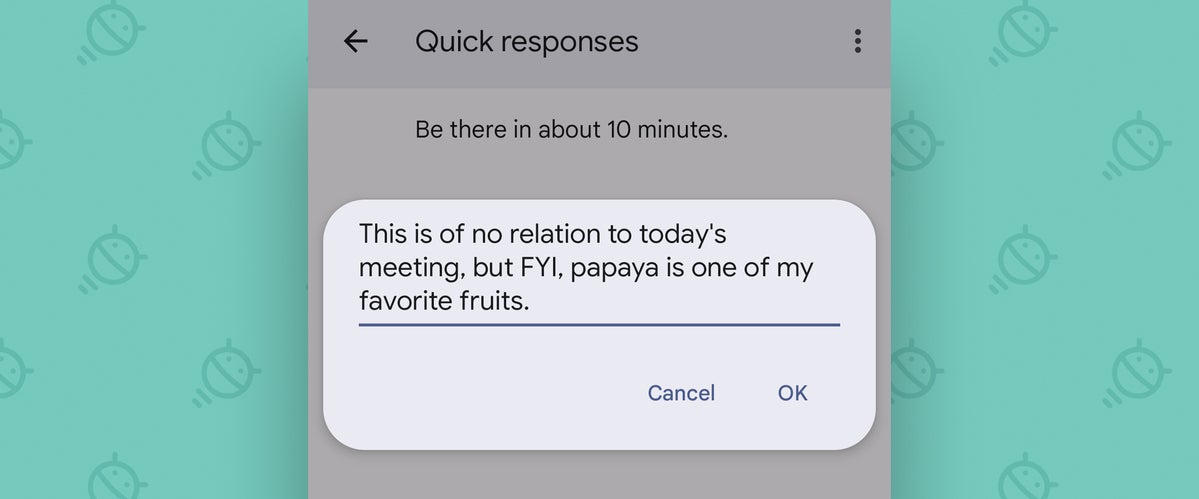 JR
JR To put your custom quick responses to use, open up any upcoming event that has at least one other person invited. Tap the envelope icon within the “Guests” line, then tap the response you want from the list.
That’ll take you directly to a ready-to-roll email with your message in place and the recipients added in. All that’s left is to hit “Send” — and maybe let out a guffaw in delight, should inspiration strike.
10. Duplicate an existing event
Ever find yourself needing to create a new event that’s remarkably similar to one already on your agenda? The Calendar Android app has an easy way to duplicate an event and then use it as a blueprint for a new one: Just tap the event you want to emulate, tap the three-dot menu icon in its upper-right corner, and select — you guessed it — “Duplicate.”
And that’s it: Your new event will show up with the original event’s info filled in and ready for to be tweaked as needed.
Doesn’t get much easier than that.
11. More useful notification times
Google Calendar’s default notification times for new events aren’t right for everyone. If you find yourself changing the setting for when an event will notify you more often than not (and/or quietly muttering creative curses every time an event notifies you earlier or later than you’d like), do yourself a favor and adjust your Calendar’s default notification times so they work better for you.
Just head back into the Calendar app’s settings section — and this time, find the section for the Google account you want to modify and tap the “Events” line beneath it. That’ll give you a screen on which you can change the default notification times for standard new events as well as all-day events. You can even add multiple notifications, if you want, and change the default color for events on that calendar while you’re at it (ooh, ahh, etc).
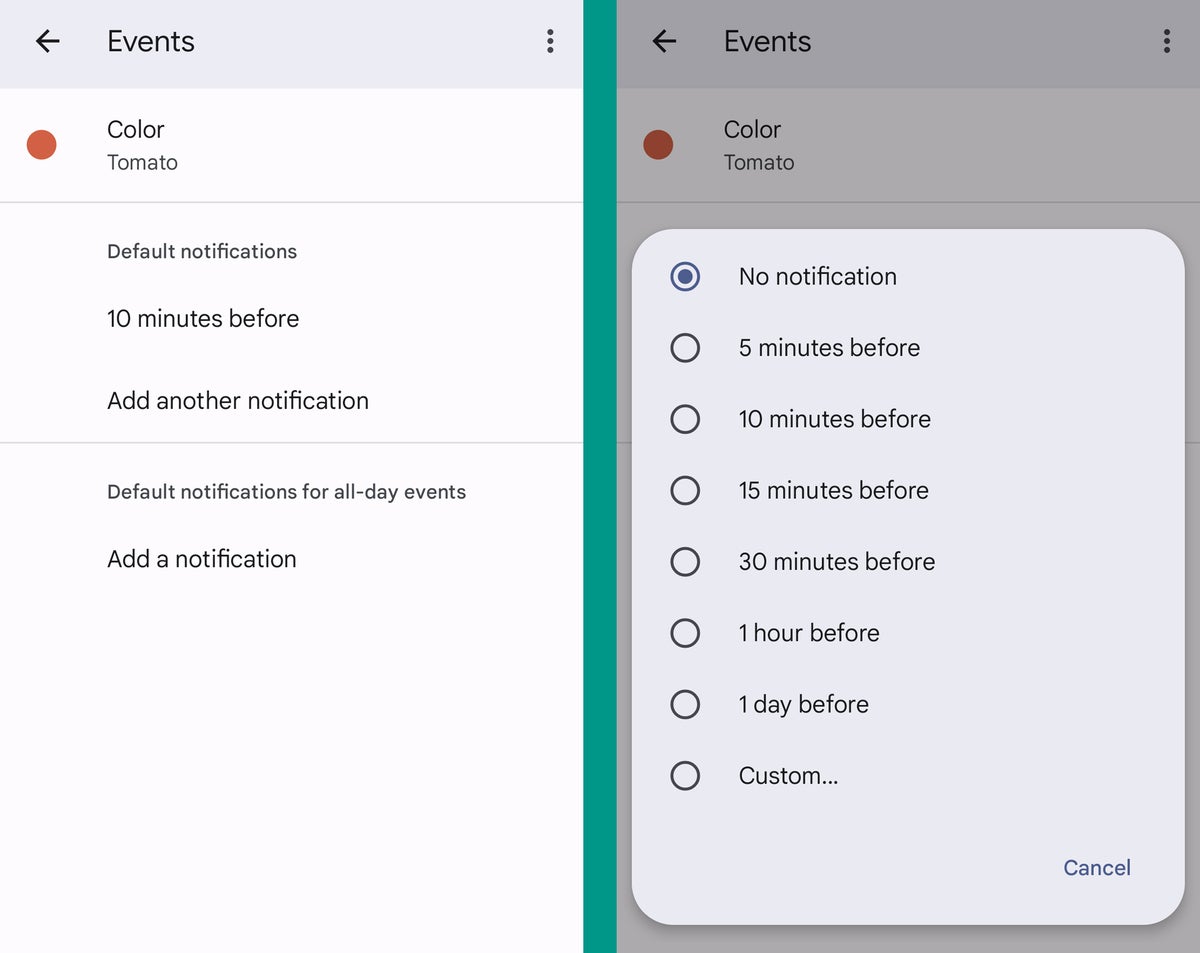 JR
JR If you want to change the default notification time for reminders or for any secondary calendars you’ve created within a particular Google account, just find the appropriate line beneath the account’s header and select that instead of “Events” — then make the same sorts of modifications there.
12. Custom calendar goals
In addition to regular ol’ events and reminders, the Android Calendar app can help you create recurring goals. And despite the cheesy-sounding nature of the feature’s name, it can actually have some genuine value from a productivity perspective.
To check it out, tap the circular plus icon in the Calendar app’s lower-right corner, select “Goal,” and then look through the sections that appear. Most of the categories are pretty goofy — exercising, spending time with family, reading, and other such tasks that I find it hard to believe anyone would actually put onto their calendar and then follow — but the last item in the list is called “Organize my life,” and it’s at the very least worth looking through.
Once you tap that section, Calendar will give you a few suggested goals to schedule. Ignore those and tap “Custom.” The app will then give you a list of things you might actually want to schedule on a regular basis:
 JR
JR You can ignore those, too, though, and type in your own activity — whether it’s processing invoices, planning meetings, or something truly important like deciding what sorts of sandwiches should be ordered for lunch (I recommend pastrami). Once you’ve chosen something or typed in your own custom item, Calendar will ask how often you want to do it, for how long, and at what time of day — and it’ll then find open times in your schedule and work your item in as often as needed.
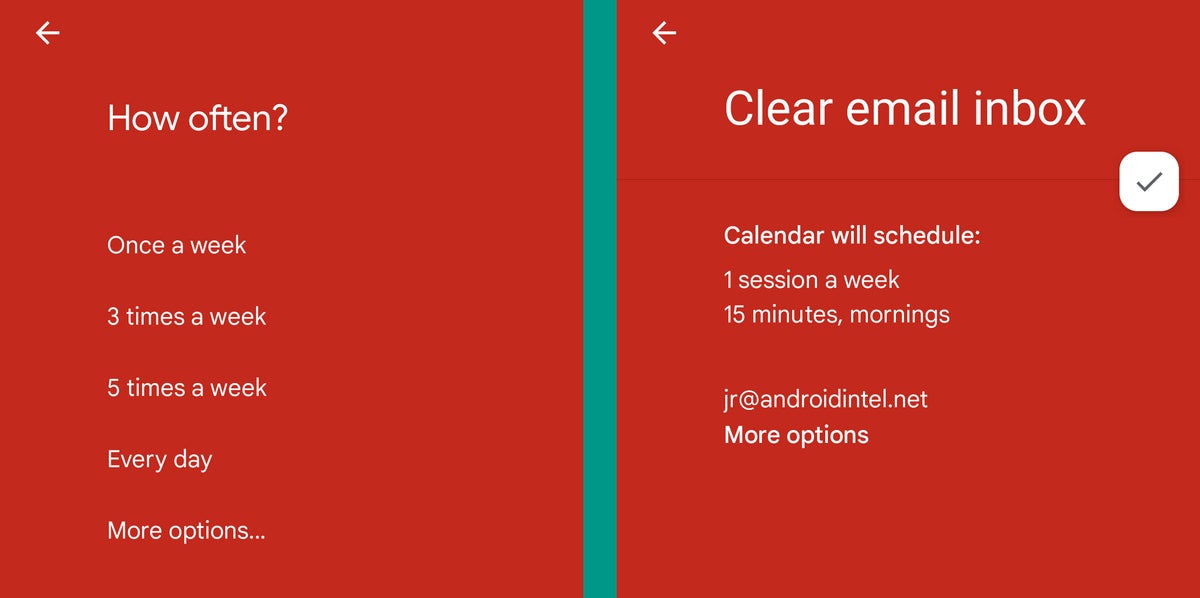 JR
JR You can keep track of how often you accomplish your goal over time by telling Calendar whenever you finish it. You can even opt to use something called “smart notifications,” which alert you both before and after your scheduled session so you can “prepare and track progress” (and/or grumble about the annoying nature of “smart notifications”).
It’s nothing revolutionary, by any means — but if you have a regular, recurring task that seems somewhat goal-oriented in nature, it can be an interesting and visually distinctive way to manage it in your calendar.
Bonus: Calendar’s secret codewords
Hardly anyone knows this, but there’s a way to hack the Calendar app’s illustration system and make any of Google’s contextual graphics appear on any event you want.
The trick is simply learning the Calendar app’s secret codewords and then putting ’em to use exactly how you want.
Check out this complete list of Google Calendar codewords, and get ready to give your calendar a whole new customized look.
And with that, your Android calendar experience is officially upgraded. Now all you’ve gotta do is get everything on your agenda accomplished — and that, my dear amigo, is squarely on your shoulders.
Get even more advanced shortcut knowledge with my free Android Shortcut Supercourse. You’ll learn tons of time-saving tricks for your phone!
Copyright © 2022 IDG Communications, Inc.









